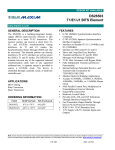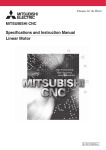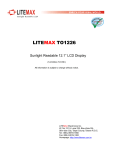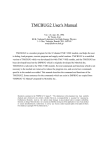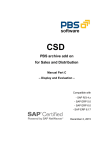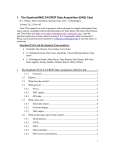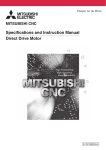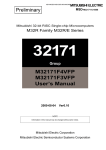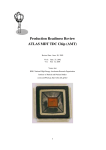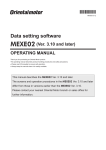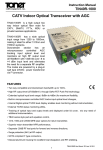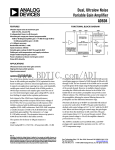Download TMC304(TEG3) User`s Manual
Transcript
TMC304(TEG3) User's Manual Yasuo Arai KEK, National Laboratory for High Energy Physics 1-1 Oho, Tsukuba, Ibaraki 305, Japan [email protected] http://www-atlas.kek.jp/~araiy/ Ver 1.5 Jan. 17, 2002 (Chip designed in 1994) TMC304 (previous name TMCTEG3) is a low-power and high-resolution multi-hit Time to Digital Converter chip. Input signals are digitized at TMC (Time Memory Cell) circuits in (clock period)/32 (0.78 ns @40MHz) time bin. The 32 bits of digitized data is then encoded into a hit bit and 5-bit data, and stored in memories. The memory is dual port memory so write and read can be performed at the same time and there is no dead time for data conversion. There are 128 words of dual port memories, and the chip can store 2.56 µs to 12.8 µs data depend on the system clock frequency. If user wants to suppress zero data at the output, signal correspond to the hit tag bit can be used as a strobe signal to next level buffer. To stabilize the internal delay element, PLL circuit is used. User can select 10 - 50 MHz system clock (x1 mode) or 2.5 - 12.5 MHz clock (x4 mode). There are 4 Control and Status Registers (CSR's) which can be read and write from 8 bit CSR bus. TMC304 chip has 4 input channels. MAIN FEATURES • Least Time Count • Time Resolution • Integral Linearity Error • Differential Linearity Error • Stability • System Clock Frequency • No. of Channels • Recording depth • Double Hit Resolution • Readout mode : 0.6 - 3.1 ns/bit : RMS = 250 ps (@40 MHz) : < 80 ps @40MHz : < 60 ps @40MHz : (3.0 - 3.6 V. 0 - 70 ˚C) : 10 - 50 MHz (x1 mode) 2.5 - 12.5 MHz (x4 mode) : 4 Channels : 128 clock cycle (2.56 - 12.8 µs) • Data format • Supply Voltage • Process : 25 - 32 ns : (i) Synchronous read mode (individual channel zero suppress) (ii) Synchronous read mode (all channel zero suppress) (iii) Asynchronous read mode (4 channel access) (iv) Asynchronous read mode (1 channel access) : dual edge encode (hit tag + 5 bit) : 3.3 V (3.0 - 3.6V) : 0.5 µm CMOS Sea-of-Gate • Power Dissipation • Package : ~ 50 mW/Channnel (@40MHz, Input=1MHz) : 0.5 mm lead pitch, 144 pin plastic QFP [• Test Circuits : Ring Oscillator, NMOS and PMOS transistors.] EDCLK CLKP CLKN ROSC TSTROSC DIV4 SF1-2 RESET* ROOUT ENRO* UP,DN COM NMOSG,D PMOSG,D WTCEN WTCLK WSTART WRUN RRUN RSTART RMOD0-1 RCLK DCH0 DCH1 RE* ZSG* Clock & Misc. Control Test Circuit Write Control Read Control Output Control WS* 6 ED VGN0 32b RTMC Latch F00-04 PLL F encoder 6 12 bit x 128 word DPM T F05 TMC304(TEG3) Block Diagram CIO0-7* WR* CS* RA0-1 T R05 R00-04 R encoder TIN0P TIN0N Test&Misc.Reg. Write Pointer Read Pointer CSR I/F CSR0,3 CSR2 CSR1 RP0-6 TIN1P TIN1N VGN1 Ch1 TIN2P TIN2N VGN2 Ch2 1995.11.13 Y.A TIN3P TIN3N VGN3 Ch3 R10-15 F10-15 R20-15 F20-15 R30-15 F30-15 INTRODUCTION A. Fine-Time Measurement The measurement of the fine time is based on a 32 tap ring oscillator as shown in Fig. 1. The circuit of the ring oscillator is modified to generate even number of equaly spaced timing signals and named “Asymmetric Ring Oscilator” [1]. The frequency of the oscillator is stabilized with a PLL(Phase Locked Loop) circuit. The level of the external signal is stored to latches at every Rising Edge Data Falling Edge Data 128W x 6b DPM 128W x 6b DPM Latch & Encoders Signal D Q D Q D Q D Q D Q • • • Asym. Ring Osc. Phase Freq. Detector Clock Charge Pump PLL circuit Fig. 1 TMC core circuit. LPF VGN Cvg PIN DESCRIPTION [I = Input, DI = Differential Input, O = Normal Output, TO = Three State Output; PU = with internal pull-up resistor, PD = with internal pull-down resistor, * = negative logic] TMC pins • EDCLK [I] : When this signal is High level, CLKP/CLKN pins are connected to a differential input receiver. When this signal is Low level, the CLKP pin is connected to a single ended input buffer and the CLKN is disconnected from the internal circuit. • CLKP,CLKN [DI/I] : System clock inputs. In a differential input mode, CLKP act as a noninverting input and CLKN act as a inverting input. In a single end mode, CLKP pin is used as the clock input. • DIV4 [I] : Divide by 4 selection. When this signal is high, the internal oscillation clock is divided by 4 before the phase comparator of the PLL. Thus the internal clock frequency has 4 times higher frequency of the system clock. • RESET* [I] : This input pin is used to reset all the internal circuit. When RESET* is asserted, internal registers and circuit are initialized. The PLL circuit does not be affected in the reset operation when DIV4 is low. When “divide by 4” mode is selected (DIV4=High), phase lock is lost at the reset. • CIO0*~CIO7* [I,TO] : These I/O pins are data lines for control bus which read and write the CSR registers. • CS* [I] : This signal is a strobe signal for the control bus. • RA0~1 [I] : These pins are used as address line to the control bus. • WR* [I] : This pin is a Read/Write* select signal in the control bus. • ED [I] : When this signal is High level, TINxP/TINxN (x=0..3) pins are connected to a differential input receiver. When this signal is Low level, the TINxP pin is connected to a single ended input buffer and the TINxN pin is disconnected from internal circuit. • TIN0P ~ TIN3P,TIN0N~3N [DI/I] : Inputs for time measuring signals. In differential input mode, TINxP act as a non-inverting input and TINxN act as a inverting input. In single end mode, TINxP is used for the input of clock. • Rxy (x=0..3, y=0..5) [TO] : These signals are output of rising edge data. The "x" denotes channel number and the "y" denotes bit number. Bit 0 to 4 indicate encoded data and bit 5 indicates a hit tag. Timing characteristic of the bit 5 is controlled by ZSG* signal, and user can select pulse or level output. The three-state output buffer is controlled by a RE* signal. • Fxy (x=0..3, y=0..5) [TO] : These signals are output of falling edge data. The "x" denotes channel number and the "y" denotes bit number. Bit 0 to 4 indicate encoded data and bit 5 indicates a hit tag. Timing characteristic of the bit 5 is controlled by ZSG* signal, and user can select pulse or level output. The three-state output buffer is controlled by a RE* signal. • RP0-RP6 [TO] : These pins provide the Read Pointer value with synchronous to the Rxy and Fxy. The three-state output buffer is controlled by RE* signal. • RE* [I] : This input controls the three-state output buffers of Rxy, Fxy and RP0-6. When RE* is asserted those output buffers are enabled as shown below. When RE* is negated, those output has high impedance. RE* 1 0 0 0 0 0 RMODE DCH0, 1 x x 0, 1, 2 x 3 0 3 1 3 2 3 3 R0y, F0y Hi Z enabled enabled Hi Z Hi Z Hi Z R1y, F1y Hi Z enabled Hi Z enabled Hi Z Hi Z R2y, F2y Hi Z enabled Hi Z Hi Z enabled Hi Z R3y, F3y Hi Z enabled Hi Z Hi Z Hi Z enabled RP0-RP6 Hi Z enabled enabled enabled enabled enabled • RMOD1~0 [I] : These pins select readout mode as shown below. RMODE 0 1 2 3 Readout mode Synchronous read mode (individual channel zero suppress) Synchronous read mode (all channel zero suppress) Asynchronous read mode (4 channel access) Asynchronous read mode (1 channel access) RMODE = [RMOD1,RMOD0] RMODE=0 is a synchronous read mode and data will appear at the output at every clock cycle. Each channel has its own hit tag bit. RMODE=1 is almost same as the RMODE0 but the R05 indicates ORed signal of all 4 channel hit tag of the rising edge. The F05 indicates ORed signal of all 4 channel hit tag of the falling edge. In addition, the R15 indicates ORed signal of all 4 channel hit tag of both rising and falling edge. All other Rx5 signals have same value as in the RMODE=0. RMODE=2 is an asynchronous read mode, and all 4 channel data are read out simultaneously controlled by RCLK. In the asynchronous mode, data recording should be stopped when reading. RMODE=3 is an asynchronous read mode. In the asynchronous mode, data recording should be stopped when reading. The data readout is done for each channel selected by DCH0 and DCH1. Readout timing is controlled by RCLK. • DCH1~0 [I] : These signals select readout channel when readout mode is 3. • RCLK [I] : This signal is used to control the data readout timing in the asynchronous read mode (RMODE=2 or 3). • ZSG* [I] : This signal controls the timing characteristics of the hit tag outputs (Rx5, Fx5). When this signal is asserted, the hit tag outputs become pulsed output and can be used to strobe non-zero data. When this bit is negated, the hit tag outputs has same timing characteristics as other data line. • WSTART [I] : This signal starts write cycle of the TMC. • WRUN [O] : This signal indicates the start of the write cycle in the TMC. This is a synchronized signal with the system clock. • RSTART [I] : This signal starts readout cycle of the dual port memory. • RRUN [O] : This signal indicates the start of the readout cycle of the dual port memory. This is a synchronized signal with the system clock. • VGN0-VGN3 [O] : These pins are outputs of PLL loop filter, and must be connected to external capacitors of ~6800 pF. • SF1 - SF2 [I] : Selection of the PLL loop filter value.These pins should be connect to Vdd. • WS* [O] : Write strobe signal. This signal can be used as a strobe signal of the data (Rxy, Fxy and RP0-6). Test purpose pins (expert only) [Following pins are used for test purpose. Normal user can leave those pins open.] • DN [O] : PLL down signal. • UP [O] : PLL up signal. • ROSC [O] : TMC ring oscillator clock output. You can check internal clock signal throgh this pin when TSTROSC pin is connected to high level. There is a PLL circuit for each channel, and you can select the channel by DCH0-1 signals as shown below. TSTROSC 1 1 1 1 0 DCH1 0 0 1 1 x DCH0 0 1 0 1 x Ch0 Ch1 Ch2 Ch3 ROSC PLL Clock PLL Clock PLL Clock PLL Clock 0 • TSTROSC [I, PD] : Enable oscillator test. When this signal is asserted, PLL oscillator output select by DCH0 and 1 is connected to ROSC pin. In addition the selected signal is also supplied to the read pointer to check the frequency. • ENRO* [I, PU] : Enable radiation test ring oscillator. • ROOUT [O] : Ring oscillator output for radiation damage test. • WTCEN [I, PD] : WTCLK enable. • WTCLK [I, PD] : Write test clock. • NMOSG, NMOSD, PMOSG, PMOSD, COM : Test transistor connections. Each pis has input protection circuit. CSR Registers CSR registers bit assignment bit 7 6 5 CSR0 MTEST (R/W:0) NRPSYN (R/W:0) CSR1 SHIFT (R/W:0) 0 CSR2 0 CSR3 SOUT (R:0) SIN (R/W:0) 4 3 2 ENRPUP TCH1 (R/W:0) (R/W:0) (R/W:0) Read Pointer register [RPR] (R/W:0) Write Pointer Register [WPR] (R/W:0) Test Data Register [TDR] (R/W:0) 1 0 TCH0 (R/W:0) F/R* (R/W:0) (R/W: x ) --- (Readable/Writeable: Initial value) * CSR0 : Miscellaneous control. • NRPSYN [read/write]: Disable synchronous count up of the read pointer with write pointer. When NRPSYN="0", the read pointer is incremented synchronous to the system clock when write cycle started. If the NRPSYN="1", this automatic count up is inhibited. • ENRPUP [read/write] : Enable automatic count up of the read pointer after asynchronous readout. When ENRPUP="1" and in asynchronous read mode (RMODE=2 or 3), the read pointer is incremented after negation of the RCLK. ---------------------- [Following bits are used to test chip. Normal user should not set these bits. ] • F/R* [read/write]: Test data select, =0 rising edge, =1 falling edge. • TCH0~1 [read/write]: Test channel select. TCH = [TCH1,TCH0]. • MTEST : Memory Test select. When this bit is set, output of the Test Data Register (TDR) is connected to the input of the DPM and the input of TDR is connected to the output of encoder logic selected by TCH bits and F/R* bit. • SHIFT : Enable Shift In/Out. When this bit is set, the value of the SIN bit is shifted into the encode register which is selected by CH bits at the end of CSR3 read/write operation..[read/write] ------------------------ * CSR1 : Read Pointer Register • RPR [read/write]: Read Pointer Register. This is a 7-bit loadable up-counter which outputs are connected to the read addresses of the Dual Port Memory (DPM). The read pointer is set through this register and read back present value of the read pointer. * CSR2 : Write Pointer Register • WPR [read/write]: Write Pointer Register. This is a 7-bit up loadable up-counter which outputs are connected to the write addresses of the Dual Port Memory (DPM). The write pointer is set through this register and read back present value of the write pointer. * CSR3 : Test Data Register [This register is used to test chip. Normal user should not set this register. ] • TDR [read/write]: Test Data Register. • SIN [read/write] : Serial Input bit. • SOUT [read only] : Serial output bit Data Encoding Scheme Digitized data at TMC circuit is encoded before the write operation to the dual port memory. The data encoding scheme is shown in the following table . Bit position at which the data is changed from "0" to "1" is encoded in the rising edge data, and bit position of "1" to "0" is encoded in the falling edge data. Hit tag bit shows the existence of those transition. In addition to the transition encoding, user can get all "0" or all "1" information by taking the encoded data at no hit tag. This may help more understanding of the signal behavior. Rising Edge row data 0 0 1 0 x d d : d d 1 0 d 1 0 d d : d d 2 0 d x 1 0 d : d d 3 0 d x x 1 0 : d d 4 0 d x x x 1 : d d 5 0 d x x x x : d d ... • • • • • • : • • • • • • • • : • • ... • • • • • • : • • 30 0 d x x x x : 0 d 31 0 d x x x x : 1 0 next cycle 0 0 d x x x x : x 1 [Rx5] Hit Tag 0 0 1 1 1 1 : 1 1 [Rx4..0] Comment Encoded Data 0 all 0 1 all 1 /no R edge 0 edge at 0-1 1 edge at 1-2 2 edge at 2-3 3 edge at 3-4 : : 30 edge at 30-31 31 edge at 31-0 31 1 u x x x x : 0 1 next cycle 0 1 u x x x x : x 0 [Fx5] Hit Tag 0 0 1 1 1 1 : 1 1 [Fx4..0] Comment Encoded Data 0 all 1 1 all 0 /no F edge 0 edge at 0-1 1 edge at 1-2 2 edge at 2-3 3 edge at 3-4 : : 30 edge at 30-31 31 edge at 31-0 Falling Edge row data 0 1 0 1 x u u : u u 1 1 u 0 1 u u : u u 2 1 u x 0 1 u : u u 3 1 u x x 0 1 : u u d..d = no rising edge u..u = no falling edge x = don't care 4 1 u x x x 0 : u u 5 1 u x x x x : u u ... • • • • • • : • • • • • • • • : • • ... • • • • • • : • • 30 1 u x x x x : 1 1 TMC304 Pin Assignments Pin No 1 2 3 4 5 6 7 8 9 10 11 12 13 14 15 16 17 18 19 20 21 22 23 24 25 26 27 28 29 30 31 32 33 34 35 36 Signal Name VDD CIO0* CIO1* CIO2* CIO3* VSS CIO4* CIO5* CIO6* CIO7* ZSG* VSS R00 R01 R02 R03 R04 VDD R05 (ROOUT) WS* RRUN TIN0N TIN0P TIN1N TIN1P VSS ED TIN2N TIN2P TIN3N TIN3P VSS VDD[PMOSD] VDD[PMOSG] (COM) Pin No Signal Name 37 VSS[NMOSG] 38 VSS[NMOSD] 39 VDD 40 VDD 41 F00 42 F01 43 F02 44 VSS 45 F03 46 F04 47 F05 48 SF1 49 SF2 50 WR* 51 (DN) 52 (UP) 53 VSS 54 CS* 55 DIV4 56 R10 57 R11 58 R12 59 R13 60 VDD 61 R14 62 R15 63 VSS 64 VSS 65 (WTCEN) 66 DCH1 67 DCH0 68 (WTCLK) 69 ROSC 70 VSS 71 (TSTROSC) 72 RE* ) Pin No 73 74 75 76 77 78 79 80 81 82 83 84 85 86 87 88 89 90 91 92 93 94 95 96 97 98 99 100 101 102 103 104 105 106 107 108 Signal Name VDD RMOD0 RMOD1 VSS F10 F11 F12 F13 VSS F14 F15 VDD VGN0 VGN1 VSS VGN2 VGN3 VDD R20 R21 VSS R22 R23 R24 R25 (ENRO*) RA0 RA1 VSS F20 F21 VDD F22 F23 F24 F25 Pin No Signal Name 109 VSS 110 RESET* 111 VDD 112 R30 113 R31 114 R32 115 R33 116 VSS 117 R34 118 R35 119 WRUN 120 VDD 121 F30 122 F31 123 F32 124 F33 125 VSS 126 F34 127 F35 128 VSS 129 RSTART 130 VDD 131 WSTART 132 RCLK 133 EDCLK 134 CLKN 135 CLKP 136 VSS 137 RP0 138 RP1 139 RP2 140 RP3 141 VDD 142 RP4 143 RP5 144 RP6 * --- negative logic ( ) -- Test Signals (leave open) F25 F24 F23 F22 VDD F21 F20 VSS RA1 RA0 (ENRO*) R25 R24 R23 R22 VSS R21 R20 VDD VGN3 VGN2 VSS VGN1 VGN0 VDD F15 F14 VSS F13 F12 F11 F10 VSS RMOD1 RMOD0 VDD 73 VSS RESET* VDD R30 R31 R32 R33 VSS R34 R35 WRUN VDD F30 F31 F32 F33 VSS F34 F35 VSS RSTART VDD WSTART RCLK EDCLK CLKN CLKP VSS RP0 RP1 RP2 RP3 VDD RP4 RP5 RP6 109 Toshiba TC180G26HS 01019423-xx JAPAN 37 RE* (TSTROSC) VSS (ROSC) (WTCLK) DCH0 DCH1 (WTCEN) VSS VSS R15 R14 VDD R13 R12 R11 R10 DIV4 CS* VSS (UP) (DN) WR* SF2 SF1 F05 F04 F03 VSS F02 F01 F00 VDD VDD (NMOSD) VSS VSS (NMOSG) VDD CIO0* CIO1* CIO2* CIO3* VSS CIO4* CIO5* CIO6* CIO7* ZSG* VSS R00 R01 R02 R03 R04 VDD R05 (ROOUT) WS* RRUN TIN0N TIN0P TIN1N TIN1P VSS ED TIN2N TIN2P TIN3N TIN3P VSS VDD (PMOSD) (PMOSG) VDD n.c. (COM) 1 n.c.=non connection, ( ) = Test Signals (leave open) TMCTEG3 Pin Assignment (Top View) 95.2.22 Y.Arai QFP144 Shrink 144-pin Plastic Flat Package (unit : mm) • Maximum Ratings Symbol VDD VIN IIN TSTG Parameter DC Supply Voltage Input Voltage Input Current Storage Temperature Value -0.3 to +5.0 V -0.3 to VDD+0.3 V ±10 mA -40 to +125 ˚C • Recommended Operating Condition ( VS S = 0V) Symbol VDD Ta Parameter DC Supply Voltage Ambient Temperature Value 3.0 to 3.6 V 0 to +70 ˚C • DC Characteristics Symbol VIH VIL IIH IIL VOH VOL IOZ IDDS Parameter Input High Voltage Input Low Voltage Input High Current Input Low Current High-Level Output Voltage Low-Level Output Voltage 3-state Output Leakage Current Quiescent Device Current Condition VIN = VDD VIN = VSS RRUN, WRUN, ROSC IOH = -4 mA (B4) All Signals except above. IOH = -8 mA (B8) RRUN, WRUN, ROSC IOH = 4 mA (B4) All Signals except above IOH = 8 mA (B8) Min VDD x 0.8 VDD x 0.2 -10 -10 2.4 Unit 10 10 µA µA V 2.4 -10 VIN = VDD or VSS Max V 0.4 V 0.4 V 10 µA 60 µA VOH-VDD(V) -3.0 -2.5 -2.0 -1.5 -1.0 -0.5 0.0 0 -20 -40 B8 -60 -80 Fig.1 Output High Level Current Characteristic (VDD=3.3V, Ta=25 °C, typ) 80 B8 IOL(mA) 60 B4 40 20 0 0.0 0.5 1.0 1.5 2.0 2.5 VOL(V) Fig. 2 Output Low Level Current Characteristic (VDD=3.3V, Ta=25 °C, typ) 3.0 IOH(mA) B4 [ AC Characteristics ] ( VDD = 3.3 V, Ta = 25 ˚C. ROSC, WRUN, RRUN : Cload = 25 pF, All other output signals : Cload = 50 pF ) • Clock Signal Characteristics Symbol f0 Characteristics CLK frequency T1 T2L/T2H Vcenter ∆V ∆V/T3 T4L/T4H T5 T6 T7 CLK rise and fall time CLK duty factor Center voltage of differential clock Differential clock amplitude CLK rise and fall rate CLK duty factor External clock and PLL clock phase offset External clock and PLL clock phase offset Rising edge delay between ROSC output and PLL clock Falling edge delay between ROSC output and PLL clock T8 Condition DIV4=L DIV4=H EDCLK=L EDCLK=L EDCLK=H EDCLK=H EDCLK=H EDCLK=H DIV4=1 DIV4=0 TSTROSC=1 Min 10 2.5 0.6 1.4 100 0.6 -4 -3 2.5 Typ 1.0 1.0 - 1.7 - 0.7 4.2 Max 50 12.5 3.0 1.4 2.6 1 1.4 1 2 6.3 Unit MHz MHz ns TSTROSC=1 2.8 4.7 7.1 ns [Clock Waveforms] 1/f0 • EDCLK=Low T2H T2L 2.0V CLKP 0.8V T1 T1 • EDCLK=High 1/f0 CLKP T4L T4H Vcenter DV T3 CLKN [Clock Offsets] CLK (DIV4=H) T5 CLK (DIV4=L) T6 PLL clock (internal) T7 ROSC (output) T8 V mV V/ns ns ns ns • CSR Access Timing Symbol T1 T2 T3 T4 T5 T6 Characteristics RA, WR* setup time RA, WR* hold time CS* asserted to CIO* asserted CS* negated to CIO* negated CIO* setup time CIO* hold time Min 1.0 2.0 4.4 2.8 0.0 3.0 Typ - Max 12 8 - Unit ns ns ns ns ns ns [CSR Read Cycle Timing Diagram] RA0-1 WR* T2 CS* T1 T4 CIO0-7* T3 [CSR Write Cycle Timing Diagram] RA0-1 WR* T2 CS* T1 CIO0-7* T5 T6 • Input Recording Timing Symbol Characteristics Condition Min Typ Max Unit T1 WSTART safety area start timing (*) 1.5 ns T2 WSTART safety area end timing (*) 0.1 ns T3 WRUN assert timing 2.8 7.1 ns T4 WRUN negate timing 2.9 7.3 ns T5 Input recording timing ∆t=bit width 7∆t ns (*) If WSTART is asserted outside of this safety area, it is not guaranteed that the input recording will start from the next cycle. User can identify the start of recording by checking WRUN signal., or synchronize the WSTART signal to CLK signal if necessary. [Input Recording Timing] (PLL clcok) T1 T2 T1 T2 WSTART T3 T4 WRUN T5 TINx T5 Data Recording (Write Pointer) (Read Pointer) N N+1 N+2 N+3 (Write Strobe*) ( ) -- Internal Signal • Readout Timing Symbol T1 T2 T3 T4 T5 T6 T7 T8 T9 T10 T11 T12 T13 T14 T15 T16 Characteristics RSTART safety area start timing (*) RSTART safety area end timing (*) RRUN assert timing RRUN negate timing RE* assert to data line enable time RE* negate to data line disable time PLL clock high to data assert time Data change to Rx5, Fx5 assert time Rx5, Fx5 pulse width (**) WS* assert to data change time WS* pulse width (**) RMOD to RRUN assert time RCLK high pulse width (=Tch) RCLK cycle time RCLK high to data assert time DCHx to channel data change time Condition RMODE=0 or 1 RMODE=0 or 1 RMODE=0 or 1 RMODE=0 or 1 RMODE=0 or 1 ZSG*=L RMODE=2 or 3 RMODE=2 or 3 RMODE=2 or 3 RMODE=2 or 3 RMODE=3 Min 3.1 2.9 3.4 3.0 3.9 0.8 Tch+0.8 0.8 Tch+0.1 3.1 5 20 4.1 3.7 Max 1.1 0.3 7.8 7.4 9.5 10.2 10.5 3.8 Tch+2.3 3.3 Tch+0.4 7.6 11.6 8.5 Unit ns ns ns ns ns ns ns ns ns ns ns ns ns ns ns ns (*) If RSTART is asserted outside of this safety area, it is not guaranteed that the readout will start from the next cycle. User can identify the start of reading by checking RRUN signal., or synchronize the RSTART signal to CLK signal if necessary. (**) Tch : Clock high time of PLL clock(RMODE=0 or 1) or RCLK(RMODE=2 or 3). Tch • RMODE=0 & 1 PLL Clock T1 T2 T1 T2 RSTART T3 T4 RRUN RE* T5 T6 T7 Rxy,Fxy RPz previous data T9 T8 Rx5,Fx5 (ZSG*=L) T10 T11 WS* • RMODE=2 & 3 RMODx RMODE=2 or 3 T12 RRUN T14 T13 (=Tch) RCLK DCHx T16 RE* T6 T5 Rxy,Fxy RPz T15 previous data T9 T8 Rx5,Fx5 (ZSG*=L) T10 WS* T11 Readout Timing +3.3V To Readout Sy s t em RMODE=0 Reset* System Clock CSR Select* Read/Write* Address Bus Data Bus* TMC304 CIO* A1 A0 CH3 RA1 RA0 WR* CS* TIN3P TIN3N TIN2P TIN2N TIN1P TIN1N TIN0P TIN0N ED CH2 CH1 CH0 CLKP CLKN EDCLK RP RP R3 F3 F3 R3 R2 F2 F2 R2 R1 F1 F1 R1 R0 F0 Level2 Buffer R0 F0 6800pF VGN3 VGN2 VGN1 VGN0 SF2 SF1 DIV4 WriteStrobe* ZSG* WSTART RSTART RCLK DCH1 DCH0 RE* WS* RESET WRUN RMOD1 RRUN RMOD0 Write Start Readout Trigger +3.3V RMODE=3 T o Readout Sy st em Reset* System Clock CSR Select* Read/Write* Address Bus Dat a B us ( CIO0 ..7* ) TMC304 CIO* A1 A0 CH3 RA1 RA0 WR* CS* TIN3P TIN3N TIN2P TIN2N TIN1P TIN1N TIN0P TIN0N ED CH2 CH1 CH0 CLKP CLKN EDCLK Write Start A1 A0 RP Dat a B us ( RP0.. 6) R3 Data Bus (R0..5) F3 Data Bus (F0..5) R2 F2 Data Read* R1 Data Strobe F1 R0 F0 6800pF VGN3 VGN2 VGN1 VGN0 SF2 SF1 DIV4 ZSG* WSTART RSTART RCLK DCH1 DCH0 RE* WS* RESET WRUN RMOD1 RRUN RMOD0 Exapmles of signal connections.





















